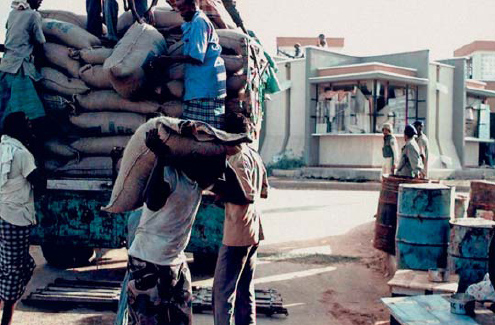
Public and UN pressure mounted on the White House to do more for Somalia. In Washington, the National Security Council (NSC) met on four occasions from November 20 to 26, 1992, to consider several options. NSC alternative plans ranged from providing only logistical support to sending an American-led and US-dominated force to oversee the mission. In Somalia, deaths due to starvation and warlord violence mounted – analysts estimated that 300,000 people died, mostly women and children. America’s commitment to world stability and the media’s attention on starving Somalis convinced Bush to expand the US commitment. Providing humanitarian aid in Somalia seemed more palatable than engaging in UN and NATO peacekeeping efforts against ethnic cleansing in Bosnia. Still, some American officials urged caution. National Security Adviser Brent Scowcroft agreed that getting into Somalia would be easy, but cautioned that getting out might be difficult. Chairman of the Joint Chiefs of Staff (JCS) General Colin Powell saw no other option but to use massive force to end the suffering, but he raised issues about entering a civil war.

Despite the presence of peacekeepers, violence and corruption plagued UN food distribution. Clans claimed control over the food, and thereby enhanced their reign over their territory and people. The increased deployment of UN forces threatened the clans’ access to this food aid. (DoD)
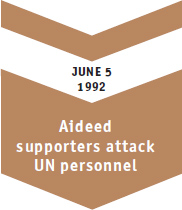
With two months remaining in office, Bush approved a plan to send a sizeable American force to support the UN, named Operation Restore Hope. The proposal went to UN Secretary General Boutros Boutros-Ghali for approval. Some nations objected to a perceived American influence, which would change the humanitarian nature of the mission. They feared a significant increase in military force structure might make the clans feel threatened and cause additional fighting. Boutros-Ghali had no alternative but to accept Bush’s offer, as the UN forces on the ground badly needed security.
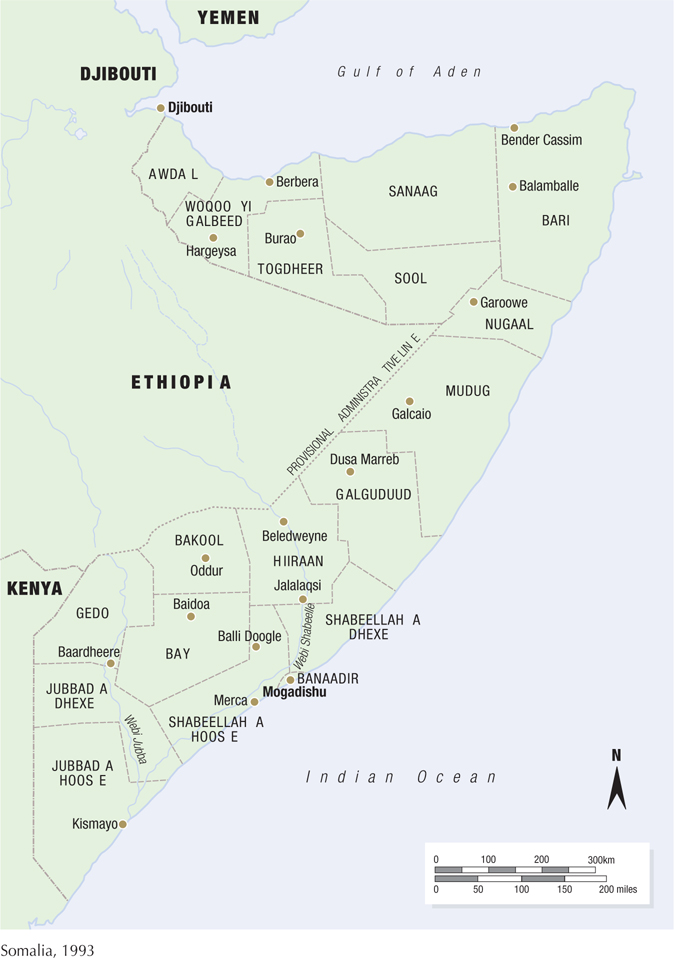
The UN’s United Task Force (UNITAF) had more than 39,000 personnel. US Marine Corps (USMC) Lieutenant General Robert B. Johnston became the top military commander, with control over American and other UN member forces. US units, organized under Joint Task Force (JTF) Somalia, fell under the US Central Command (CENTCOM), and Johnston controlled the 1st Marine Division and the Army’s 10th Mountain Division.
Washington had about 28,900 personnel in Somalia. Their mission included keeping routes opened for relief supplies, securing air and sea ports, providing security for relief efforts, and assisting UN/NGO humanitarian operations. Combining diplomatic efforts with a massive military presence and humanitarian relief did help quiet and pacify the clans. Washington sought to secure areas in Somalia and then turn responsibility over to the UN.
Somali clans, especially Aideed’s Habr Gidr, detested the UN. Aideed harbored a personal hatred for Boutros-Ghali, as the UN Secretary General had supported the Barre regime when he was the Egyptian Foreign Minister. Aideed and others started to challenge UNITAF and fights between clans arose. Ali Mahdi Mohamed, one of Aideed’s bitterest rivals in Mogadishu, from the Abgal sub-clan of the Hawiye, sought control of the capital. Both clans clashed in the streets. The United States tried a new tactic to restore order, using Ambassador Robert Oakley to negotiate a ceasefire among the Somali factions. Combined with Johnston’s JTF Somalia, the clans seemed outmatched and they agreed to a tentative ceasefire.
Boutros-Ghali wanted a permanent solution through clan disarmament. CENTCOM commander Marine Corps General Joseph Hoar disagreed. This effort would entail a widening of the JTF Somalia mission. Creating secure areas worked because of a tenuous peace between UNITAF and the clans. A source of power and money evaporated from the clans when open robbery of the food relief and other crimes ceased, largely through UNITAF’s presence – illegal arms sales, food distribution control, and the khat narcotic trafficking provided most of the clans’ economic activities. However, any efforts to disarm the warrior-dominated clans would mean war. UN officials deferred a fight when they brokered a deal for the clans to secure their weapons in a cantonment area or authorized weapons storage sites (AWSS). Still, American military forces started to sweep areas for clan weapons, despite efforts to create a Somali police force to conduct these and other operations. Unfortunately, the Somali police were undertrained, ill-equipped, and overwhelmed by the clans. The United States was stuck; the mission had expanded to stabilizing a region where no one could tell who was a foe.
Despite the clans’ acceptance of the AWSS facilities, weapons were readily available to any Somali. Firearms were a part of Somalia’s warrior culture, in which protection of family and clan was an integral part of life. Violent clashes between clans continued. One incident, in Kismayo, between a clan loyal to Barre and an Aideed ally, occurred on January 24, 1993. UN officials charged Barre’s son-in-law, General Said Hersi Morgan, with violating the ceasefire and told him to leave the city. After Morgan refused to depart, UNITAF forces destroyed some of his weapons, including four howitzers, several vehicles, and six trucks mounting recoilless rifles, machine guns, or other weapons, known by the Somalis as “technicals.” He returned later on February 22 to attack Kismayo and Aideed supporters, but the effort failed when Belgians and American units forced both sides to disengage.
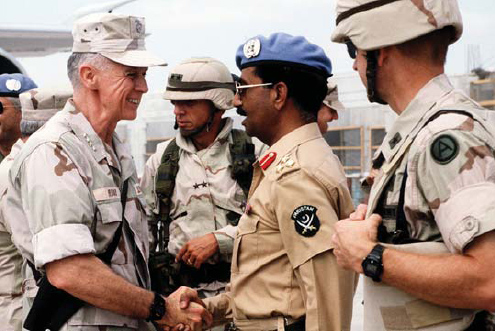
General Joseph Hoar, CENTCOM commander, controlled the Americans assigned both to the UNOSOM and UNITAF missions, and later TFR. Hoar was originally against the use of SOF under TFR in Somalia. (DoD)
Unfortunately for UNITAF, major political damage occurred. Aideed had received some false reports that the UN forces had sided with Morgan and the ceasefire and UN peacekeeping efforts had eroded Habr Gidr power. Local officials started to displace the clans in cities. Aideed’s anger swelled and he took action.
On February 24, violence spread to Mogadishu. The Habr Gidr clan mobilized to demonstrate against the UN and American presence. The US embassy and UN peacekeepers became targets. Protestors did little damage to the embassy, but over the course of the day Aideed supporters wounded several US Marines and killed two Somali policemen. The fighting continued the next day. American, Nigerian, and Botswanan peacekeepers had to quell protests in Mogadishu. Although the protests were relatively small, the media played up the problems.
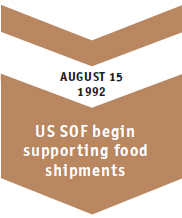
The UN had created some stability in Somalia: a ceasefire had occurred and food distribution continued. Washington now wanted to transfer the major peacekeeping effort to the UN, but the situation changed. President Bill Clinton replaced Bush in January 1993 and he inherited the situation in Somalia. UNOSOM transitioned to UNOSOM II. The UN mission now shifted from humanitarian actions to combat operations under Boutros-Ghali, as clan disarmament became a primary objective to enforce peace. UNOSOM II’s military mission was to conduct “operations to consolidate, expand, and maintain a secure environment.” Under Turkish Lieutenant General Çevik Bir, 28,000 soldiers tried to secure cities, prevent and respond to fighting, control and confiscate weapons, and protect UN activities and personnel. US Army Major General Thomas Montgomery served as Bir’s deputy. Montgomery was also commander of US Forces Somalia, with a separate chain of command to CENTCOM, to allay fears of Americans being solely under UN control. About 1,300 men of the US Army’s 10th Mountain Division became a quick-reaction force (QRF) to respond to any problems that exceeded the UN force’s capabilities, including search and attack missions. USAF AC-130H Spectre gunships based in Kenya provided overhead support.
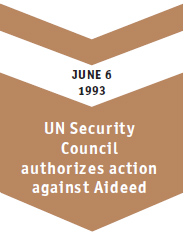
Despite US/UN efforts to try to rebuild Somalia, the clans were skeptical. Aideed believed the UN helped his rivals. During some AWSS inspections on June 5, Aideed followers attacked Pakistani soldiers. Aideed’s supporters had warned that if the UN insisted on AWSS inspections, this activity would translate to a war declaration. Aideed was also concerned that the UN inspections might discover “Radio Aideed,” a major propaganda outlet near the AWSS locations. On their return to base, UN Pakistani inspectors faced large crowds on the 21 October Road and, hiding behind women and children, Habr Gidr militiamen ambushed the UN personnel. Another attack occurred at a feeding site on June 5, where the mob killed 23 Pakistanis and Aideed followers captured six more – one died in captivity. The inspectors found evidence of missing technicals and large stocks of TOW (tubelaunched, optically tracked, wire command data linked guided) missiles, and other weapons. Boutros-Ghali and other international leaders were livid. Aideed had effectively declared war on UNOSOM II.
On June 6, UN Security Council Resolution 837 was passed. This resolution directed UNSOM II personnel to take all necessary measures against those responsible for the previous day’s attack. UN forces conducted tactical operations to arrest Aideed followers, while AC-130s hammered weapon storage areas. UN patrols tried to disarm Somalis, and clan militias responded by ambushing UN patrols, mining roads, and setting up blockades. As a result, the UN posted a $25,000 reward on Aideed.
On July 12, UN forces struck the Abdi House, where members of the USC and Somali National Alliance (SNA) were meeting. The SNA was a political group supportive of Aideed. Intelligence reports indicated the house was a place where Aideed planned his operations, so QRF and American AH-1F and OH-58 helicopters launched a coordinated assault to decapitate the SNA. The AH-1s fired 16 TOWs, and Black Hawk helicopters and trucks delivered troops into the area. The Americans struck the SNA hard. The International Red Cross estimated 54 Somalis killed, but the SNA claimed 74 dead, one of whom was an SNA imam. SNA followers also argued that the meeting was developing a plan for an overture to UN peace discussions. In revenge, SNA militiamen killed four reporters who arrived after the attack. This raid ended any possibility of a political settlement.
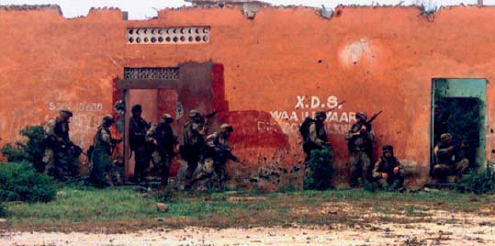
The US Marines conducted several raids to capture weapons from Somali warlords. Here, Marines search a cantonment area controlled by Aideed’s clan in northern Mogadishu. These building-to-building searches had mixed results. (DoD)
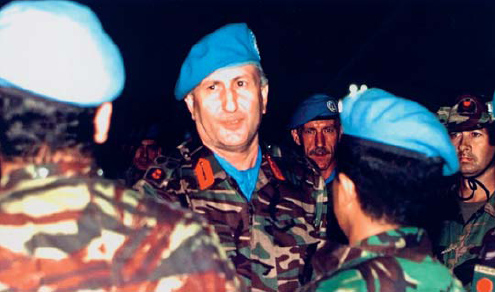
Lieutenant General Çevik Bir took command of UNOSOM II. The split command relationships between the UN forces and Americans would affect military activities. Although informed of American operations, Bir did not have a say in all activities in Mogadishu involving Americans. (DoD)
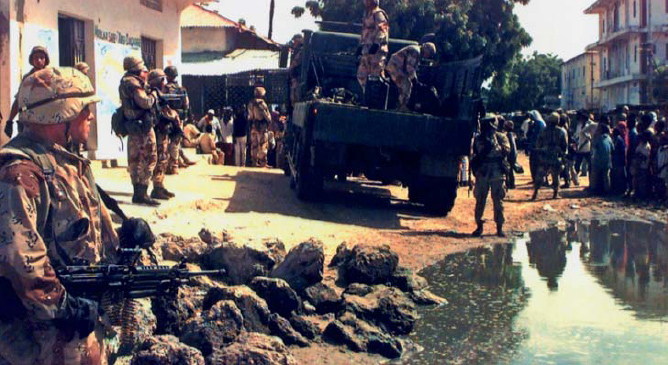
The US Marines provided security for the early humanitarian efforts in Somalia. UNITAF assets had to deal with clan warfare while protecting a number of UN activities to help starving Somalis and bring the country back from the brink of disaster. Here, Marines secure illegal arms and munitions taken in the Bakara Market area that would have armed clan militiamen. (DoD)